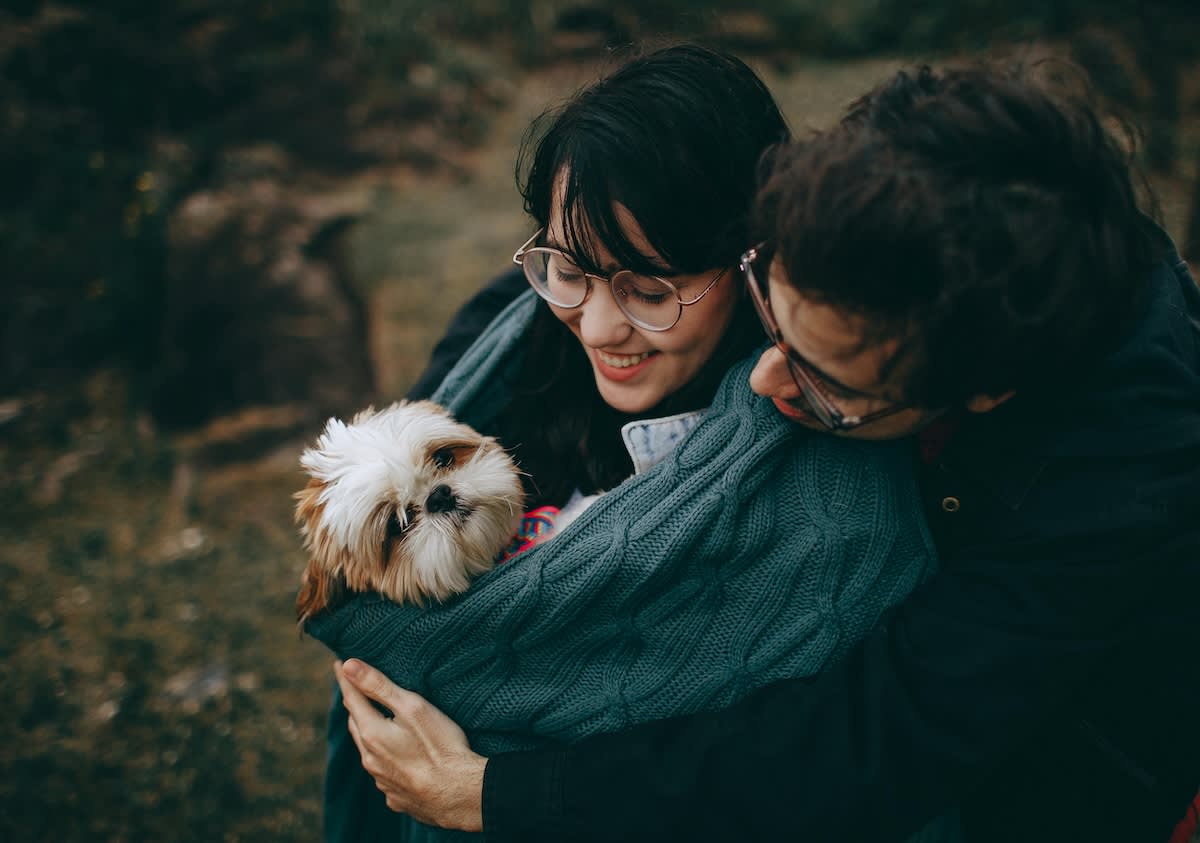Actually, Science Says We Love Dogs Just As Much As We Love Our Babies
Dog love = baby love

Share Article
“You don’t get it. I know you love your dog, but nothing feels like the love you have for your baby.”
I could feel my heart breaking. I wanted to cry.
My friend and I were having dinner and chatting about life and love and kids and the fact that I don’t have any. I don’t think she meant to hurt me; she just doesn’t want me to go through life and never experience the kind of devotion she has for the humans she birthed. I get it. I want that kind of all-consuming love, too. I want to feel all the emotions I possibly can while I’m living this short life.
But my friend doesn’t even like dogs – I know, I know – and so therefore will never know the rush of love I feel as I cradle my rescue dog Lucy’s head in my hands and stroke her face. The warmth in my body as she lifts her paw to request more scritches or the utter contentment of our morning snuggles, her body squished into mine, the tip of her nose touching the tip of mine. Or the journey we’ve been on – how watching her transform from a nervous creature who jumped at every sound to the most loving, happy girl. All because my husband and I made her feel safe and nurtured. I am crying as I type this – if that’s not love, then I don’t know what love is…
I know other dog parents who feel like this, too – a pure devotion unmatched by the relationships they have with other humans. One of my most favourite pieces of writing for Kinship involved meeting some gorgeous people who‘ve built their family with pets instead of childrenopens in new tab. And something tattoo artist Kate said about their rescue dog Charlie Brown really stayed with me. “We didn’t ‘choose’ Charlie per se, he was offered to us and we waited patiently for the transport van to arrive, not knowing the size, shape or demeanour of our charge – in a way, like an expectant parent. You also don’t know this person you’re going to meet, but you promise to love and care for them as you find them.”
And, it turns out, science, research and experts all prove that something really does happen in our brains when we take home a dog, a chemical shift that actually matches how mothers feel for their newborns – yep, let’s take a look…
Do we love dogs as much as kids? Science says...
Multiple studies show that the love humans have for their canine family members is akin to the love that parents feel for their (human) babies. A brain imaging studyopens in new tab (conducted back in 2014) set out to discover what exactly causes people to feel so intensely about their dogs. Researchers from Harvard University gathered together a group of mums who had at least one child (between the ages of two and 10) and a dog (who’d also been in the family for at least two years). The mothers were then put into MRI machines and shown images of both dogs and kids – some were theirs and some weren’t.
And, amazingly, there was significant overlap between the emotional experience of the mother-child relationship and the mother-dog relationship. The study concluded that: “The amygdala, thought to be a critical region for bond formation, was activated to both the own child and dog images.” So, when you look at your dog, your brain lights up in the exact same way that it would if you were gazing into the eyes of your baby. (No, you’re crying!)
There’s more... A study by the University of Kentopens in new tab, published earlier this year, shows that having a dog in your life makes you as happy as receiving an extra £70k a year in your pay packet – yep, that’s how much life satisfaction having a pup in the family gives you. Another study by Eötvös Loránd University in Hungary, published this year in the journal Scientific Reportsopens in new tab, found that pet parents rate their relationship with their dogs as satisfying or more satisfying than their closest human relationships; on a companionship and nurture level, dogs rated higher than best friends and romantic partners. “Dogs offer a highly positive relationship with minimal conflict, strong social support, and the unique opportunity to have full control over another living being’s life,” noted Prof Enikő Kubinyi, senior author of the Hungarian research (children, of course, grow independent and eventually move out). Borbála Turcsán, the study’s first author, even concluded that: “Dogs can be (almost) anything we want them to be.”
On top of that, this studyopens in new tab in Society & Animals suggests that people view dogs as vulnerable creatures (like babies of the human variety) that need protecting. Plus, of course, puppies are cute and so are babies, and that perception of cuteness is felt across species as illustrated in a study published in Plos Oneopens in new tab – big humans needed to find little humans cute to survive, and that’s kind of how it works with dogs too...
The secret ingredient? Oxytocin
Dr Zachary Silver is a professor of psychology at Occidental College in LA, where he runs the Canine Intelligence Lab. When Dr Silver isn’t hanging out with his dog, Maritza, he’s studying canine social intelligence. And he believes we need to time-travel back 40,000 years to understand the love we feel for our dogs today. “As early evolving humans, we were willing to keep slightly more tame and slightly more friendly wolves around us,” he explains. “We would share our food scraps with them. It‘s the reason that dogs today will eat things like bones* – their digestive system evolved to sustain themselves off of the things that humans could not eat.”
Eventually, Dr Silver explains, dogs evolved into being our “cooperators and collaborators” and humans found they could hunt effectively with dogs. In turn, dogs learned how to look at our eyes for cues to know what we wanted from them. “Eye contact,” Dr Silver continues, “is also one of the key mechanisms that promotes bonding between humans and our children.”
Dr Silver explains that when we look into our newborn baby‘s eyes, a hormone called oxytocin is produced. “And oxytocin is this bonding affiliation hormone that is a really crucial ingredient in why we form such immediate and strong attachments to our offspring, and why they form such immediate and strong attachments to us. That’s an oxytocin loop”
Plot twist, there’s only one example across the entire animal kingdom of a situation where we see this oxytocin loop across different species – “that’s both parties producing oxytocin when engaged in mutual eye contact,” explains Dr Silver – and that’s in dogs and humans.
As to the whys and the hows, Dr Silver isn’t sure. “But at some point in our evolutionary history, something happened,” Dr Silver explains, “dogs kind of hijacked our oxytocin system, they were able to ascertain – somehow – that humans paid closer affiliation to the individuals that they looked at for long durations of time, and then sort of copied the behavior. Then, over many generations, they themselves started producing oxytocin as well.” (FYI, there’s also a study in the journal Science on exactly thisopens in new tab.)
*FWIW, don‘t feed bones to your dog at home! They can cause a number of health issues.
Can I love a cat like my child?
Oof, I’m most definitely feeling the love now that I know Lucy is also feeling the love for me. But I tell Dr Silver that Lucy didn’t always feel comfortable looking into my eyes. Over the course of the past five years, I’ve felt her gaze intensify. And now, it sometimes feels like she’s looking right inside me.
“It’s normal for people to have dogs that don’t feel like they want to initiate eye contact with humans right away,” says Dr Silver. “There are other ways to facilitate that bond, and once they reach the point where they want to gaze into your eyes, then you start to see that relationship build even further, because oxytocin is now facilitating that additional bonding.”
So, could you feel this kind of connection with another pet, a cat, for example? “Theoretically, this would be possible for any species that has an inclination to stare into our eyes frequently,” concludes Dr Silver, “and it could emerge elsewhere. But I think what makes dogs so unique is that they’ve had that reason for such a long part of their evolutionary history.” Dr Silver explains that there was never an evolutionary pressure for other animals, such as cats or horses, for example, to initiate and sustain eye contact with humans.
How to make that bond even stronger
Dr Silver notes that evolution operates considerably slower than cultural change. “When we see changes in how we interact with animals, well, a human lifespan is maybe like a day in terms of an evolutionary timeline,” Dr Silver notes – “maybe even an hour.”
“It took 40,000 years for dogs to get to the point where they are right now,” he continues. “And there are mixed opinions about whether this is our dogs’ forever state, or if there is evolution ongoing.”
If anything, Dr Silver would be most concerned that people aren’t spending enough time with their dogs. “The role of technology in human lives and how frequently we turn to our phones – that wasn’t present in dogs’ evolutionary building blocks, so they don’t know how to step into those situations.” New changes can disrupt the bond that’s built up over thousands of years, so Dr Silver encourages everyone to put down their phones and look at their dog instead. “And look at what your dog is looking at too,” recommends Dr Silver. “Bonding with your dog can be as simple as sitting with them to show that you’re attending only to them – that’s how they understand human attention.”
So there we have it. Your dog really is your child, and science proves you love them just as much as you would if you’d birth them yourself. And they really do love you back.
Resources
Stoeckel, L.E., Palley, L.S., Gollub, R.L., Niemi, S.M. and Evins, A.E. (2014). Patterns of Brain Activation when Mothers View Their Own Child and Dog: An fMRI Study. PLoS ONE, 9(10), p.e107205. doi:https://doi.org/10.1371/journal.pone.0107205opens in new tab.
Miller, O. (2025). New study proves pets increase human life satisfaction and wellbeingopens in new tab. [online] News Centre - University of Kent.
Turcsán, B., Ujfalussy, D.J., Kerepesi, A., Miklósi, Á. and Kubinyi, E. (2025). Similarities and differences between dog–human and human–human relationships. Scientific Reports, [online] 15(1). doi:https://doi.org/10.1038/s41598-025-95515-8.opens in new tab
Levin, J., Arluke, A. and Irvine, L. (2017). Are People More Disturbed by Dog or Human Suffering? Society & Animals, 25(1), pp.1–16. doi:https://doi.org/10.1163/15685306-12341440opens in new tab.
Golle, J., Lisibach, S., Mast, F.W. and Lobmaier, J.S. (2013). Sweet Puppies and Cute Babies: Perceptual Adaptation to Babyfacedness Transfers across Species. PLoS ONE, 8(3), p.e58248. doi:https://doi.org/10.1371/journal.pone.0058248opens in new tab.
MacLean, E.L. and Hare, B. (2015). Dogs hijack the human bonding pathway. Science, 348(6232), pp.280–281. doi:https://doi.org/10.1126/science.aab1200opens in new tab.

Alice Snape
Alice Snape is a freelance writer and editor whose work has featured in Cosmopolitan, Metro, Red, Vice, amongst other publications. Her rescue dog Lucy is the love of her life – probably because she’s an anxious weirdo like her. You’ll likely find them both curled up in bed – Alice’s favourite place to write from – or out having an adventure together in the park…